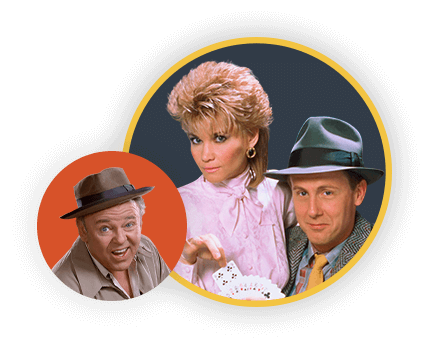8 fast, fascinating facts about The Fugitive

Image: The Everett Collection
"The name: Dr. Richard Kimble. The destination: Death Row, state prison. The irony: Richard Kimble is innocent."
So began the early episodes of The Fugitive. Networks had never aired anything like this television. As soon as the show premiered in 1963, audiences were hooked. Here was a hero who was not a lawman, rather on the run from the law. And not for a white-collar crime like tax evasion. He was pegged for murder!
The week-to-week action, as Kimble hopped around the country on the lam, wowed viewers, but it was the ongoing mystery that kept them coming back.
If Kimble did not kill his wife, who did?
Americans had to wait four years for the thrilling climax. Other dramas wrapped up their plots neatly in one hour. This tale took 120 episodes. The shocking finale was worth the wait. It's no wonder that The Fugitive has stuck in the mind of the public. Harrison Ford revitalized the Kimble character on the big screen in 1993, turning on a whole new generation.
Let's run through some fascinating facts about The Fugitive.

The train crash footage was from a 1938 comedy.
Kimble manages to escape when his train derails en route to Death Row. Locomotive crashes do not come cheap in Hollywood, so the producers lifted footage from an old flick, The Young in Heart, a Douglas Fairbanks Jr. romcom from 1938. Not only did the movie feature some nifty, futuristic cars, the characters survived a train derailment on a bridge. Here you can see the train in the TV show credits in color, and the original scene in black and white.

The series was somewhat inspired by Les Miserable.
Series creator Roy Huggins (Maverick, The Rockford Files) repeatedly denied that his series had been inspired by the real-life case of Sam Sheppard, a doctor accused of murdering his wife in 1954. (After ten years in prison, he was acquitted.) Make of that what you will. The over plot also has echoes of Victor Hugo's Les Miserables, which featured a fugitive protagonist, Jean Valjean, eluding an inspector named Javert, who is not too far off from the "Lt. Gerard" of the TV show.

It pioneered narrative television.
Ongoing narratives are the norm for modern television. In fact, it's a rarity to find a drama in episodic form, like The Twilight Zone or Star Trek. Back in the day, if you missed an episode, you could easily tune in the following week and not miss a beat. It had to be that way without recording devices. The Fugitive boldly asked — demanded, really — audiences to tune in every single week. Yes, it told a different contained tale each episode, but the ongoing plot with the One-Armed Man and Lt. Gerard keep viewers on their toes. The network was initially skeptical to even try such a concept. It blazed a trail for similarly structured shows like The X-Files.
Image: The Everett Collection

Nearly half of America watched the finale.
After four years, Kimble finally confronts the One-Armed Man, high atop a carnival tower. A whopping 45.9% of households tuned in to see the climax, which amounted to a 72% (meaning, of all the people watching TV at that time, about two-thirds of them were tuned in to The Fugitive). It would remain the most-watched episode until the 1980s, when it was surpassed by the "Who Shot J.R.?" reveal on Dallas and, eventually, the tearful M*A*S*H finale.
Image: The Everett Collection

The final narration had to be changed for Canada.
The stentorian voice of William Conrad made him the perfect narrator for The Fugitive. (Likewise, the Cannon star was the narrator for both Buck Rogers in the 25th Century and Rocky and Bullwinkle.) At the end of the final episode, "The Judgement," Conrad declared, "Tuesday, August 29. The day the running stopped." That coincided with the original airdate on ABC, August 29, 1967. Only, the episode did not air until September 5 in Canada. Those perfectionists changed the narration to say "September 5." At least it was still a Tuesday.
Image: The Everett Collection

A lot of the music was recycled from other shows.
As brilliant, gripping and groundbreaking as the show was, it did recycle a good deal. We mention the train wreck, but there was a far for subtle reuse. Perhaps keen listeners picked up on it. Musical cues from The Outer Limits and The Twilight Zone were pulled out of the library to accompany Kimble on his run. Music from 12 O'Clock High and Branded was also used.

Kimble's background was changed because of state laws.
At the show's conception, Kimble began his journey from his home state of Wisconsin. However, writers and producers soon realized that Wisconsin did not execute murderers. So, Kimble's backstory was shifted a couple states over to Indiana. His hometown, as seen on this wanted poster, was Stafford, IN. However, in the first-season episode "Glass Tightrope," Kimble's hometown is listed on a poster as Beloit, Wisconsin. They didn't entirely clean up the mistake.
Image: The Everett Collection

You can find a lot of famous faces in the show.
Star Trek fans can find beloved Enterprise crew like DeForest Kelley, James Doohan and William Shatner (pictured) on The Fugitive. Charles Bronson, Ron Howard, Kurt Russell, Leslie Nielsen, Suzanne Pleshette, Ted Knight, Carroll O'Connor, Mickey Rooney and dozens of other celebs turn up in Kimble's path, too.




